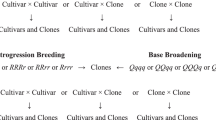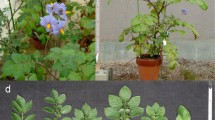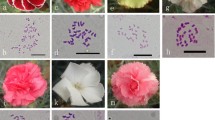Summary
Electrophoresis banding patterns of the tuber proteins of 12 dihaploids of the cultivar Pentland Crown showed that four had types of patatin unlike that of the parent. The patatin types of somatically chromosome-doubled clones derived from three of the dihaploids were identical to those of the dihaploid progenitors. Fourteen dihaploids produced from the chromosome-doubled derivative (PDH40X2) of one dihaploid, which had a variant patatin, had the patatin type of the parent dihaploid.
The experiment showed that dihaploids and somatic chromosome doubling could be used to fix variation found in heterozygous tetraploid potatoes. Used together, haploidisation and chromosome doubling can generate highly homozygous tetraploids for use by plant breeders.
Similar content being viewed by others
References
DeMaine, M.J., 1978. Field resistance to late blight and potato root eelworm in Group Tuberosum dihaploids. Euphytica 27: 305–315.
DeMaine, M.J., 1982. An evaluation of the use of dihaploids and unreduced gametes in breeding for quantitative resistance to potato pathogens. J. agric. Sci., Camb. 99: 79–83.
DeMaine, M.J., 1984. Patterns of variation in potato dihaploid familles. Potato Res. 27: 1–11.
DeMaine, M.J., 1987. Comparisons of cell characters in leaves of dihaploid potatoes, their chromosome-doubled derivatives and parthenogenetic tetraploid parents. Potato Res. 30: 253–266.
DeMaine, M.J. & J.A. Fantes, 1983. The results of colchicine treatment of dihaploids and their implications regarding efficiency of chromosome doubling and potato histogeny. Potato Res. 26: 289–294.
DeMaine, M.J. & H.E. Stewart, 1988. An assessment of the fertilizer response and other characters of three dihaploid potato clones and the characteristics of their tetraploid progenies. Euphytica 39: 25–31.
DeMaine, M.J., L.A. Farrer & M.S. Phillips, 1986. Breeding for quantitative resistance to potato cyst nematode (Globodera pallida) in tetraploid potatoes using dihaploids and unreduced gametes. Euphytica 35: 1001–1006.
Jervis, L., A.L. Shepherd & M.J. De Maine, 1986. Variations in soluble tuber proteins in tetraploid, dihaploid and doubled dihaploid potato (Solanum tuberosum). Biochem. Soc. Trans. 14: 1096–1097.
Laemmli, U.K., 1970. Cleavage of structural proteins during the assembly of the head of bacteriophage T4. Nature (Lond.) 227: 680–685.
Lumsden, J. & J.R. Coggins, 1977. The subunit structure of the arom multi-enzyme complex of Neurospora crassa. A possible pentafunctional polypeptide chain. Biochem. J. 161: 599–607.
Pikaard, C.S., J.S. Brusca, D.J. Hannapel & W.D. Park, 1987. The two classes of genes for the major potato tuber protein, patatin, are differentially expressed in tubers and roots. Nucleic Acids Res. 15: 1979–1993.
Ross, R.W., L.A. Dionne & R.W. Hougas, 1967. Doubling the chromosome number of selected Solanum genotypes. Eur. Potato J. 10: 37–52.
Uijtewaal, B.A., E. Jacobsen & J.G.Th. Hermsen, 1987. Morphology and vigour of monohaploid potato clones, their corresponding homozygous diploids and tetraploids and their heterozygous diploid parent. Euphytica 36: 745–753.
Author information
Authors and Affiliations
Rights and permissions
About this article
Cite this article
De Maine, M.J., Jervis, L. The use of dihaploids in increasing the homozygosity of tetraploid potatoes. Euphytica 44, 37–42 (1989). https://doi.org/10.1007/BF00022596
Received:
Accepted:
Issue Date:
DOI: https://doi.org/10.1007/BF00022596




